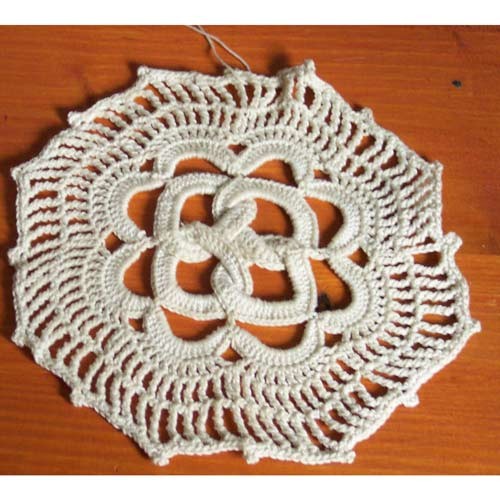Crochet Small Doily/Coaster
Crocheting small doilies or coasters is not only a delightful craft but also a practical one. These charming creations serve as lovely decorations for your home while also protecting your furniture from scratches and spills. Whether you're a seasoned crocheter or a beginner, making a doily is a fun and rewarding project that allows you to showcase your creativity and attention to detail. With a variety of patterns and colors to choose from, you can customize your doilies to match any room or occasion. So, grab your crochet hook and yarn, and get ready to add a touch of handmade charm to your living space with these delightful doilies/coasters!

Size: 18 cm (7 inches) diameter
Material: Pearl cotton # 5, hook 1.7 mm (Boye steel #7); you can substitute with Cebelia #10 or equivalent cordonnet thread (but the gauge can slightly vary)
Stitches: ch, sl st, sc, dc, tr, dtr, picot (4 ch, sc in first ch)
Difficulty: medium/difficult.
Directions
Doily is composed of a center, with 4 rings interlaced, and an around part.
Rings
1st ring: start with 20 ch, join with sl st; 40 sc in loop, join with sl st in first sc, cut thread;
2nd ring: start with 20 ch, pass them across first ring,; join with sl st; 40 sc in loop, join with sl st in first sc, cut thread;
3rd ring: start with 20 ch, pass them across second ring, join with sl st; 40 sc in loop, join with sl st in first sc, cut thread;
4th ring: start with 20 ch, pass them across first and third rings, join with sl st; 40 sc in loop, join with sl st in first sc, do not cut thread;
Surrounding
1. * 1 sc inserting the hook in overlaying st in first and second ring; 12; ch, sk 10 ch on 2nd ring, sc in center of second ring, 12 ch *; Repeat from * to * 3 times more; join with sl st in first st. (eight 12-ch lps)
2. * (sc, 2 hdc, 15 dc, 2 hdc, sc) in lp *; Repeat from * to *; 7 times more; join with sl st in first st.
3. sl st to 3rd dc of first lp, +1 dc, 1 ch +; Repeat from + to + 9 times more; 1 dc on next dc, sk next 10 st *; Repeat from * to * 7 times more; join with sl st in first st.
4.; 4 ch * + tr on dc, 2 ch +; Repeat from + to + 8 times more; (not closed tr on next dc) twice, close last two tr together, 2 ch*; Repeat from * to * 7 times more; join with sl st in first st.
5. * dtr on tr, 2 ch *; Repeat from * to * around; join with sl st in first st. .
6.; * (2 sc in next loop) 5 times, 1 sc in next dtr, picot *; Repeat from * to * around; join with sl st in first st. Cut thread.
N.B.
- Always substitute (also if not explicitly said) first st in a row as follows:
- first sc with 1 ch, sc;
- first hdc with 2 ch;
- first dc with 3 ch;
- first tr with 4 ch...and so on;
- When you read «sl st to <location>», where the location is not immediately contiguous to last st, this means of course «an appropriate number of sl sts for reaching <location>».
- Also if I do not specify it, if you lasted prev row on a st (say st1), while you must start next row in another st (say st2), make an appropriate number of sl sts to reach st2.